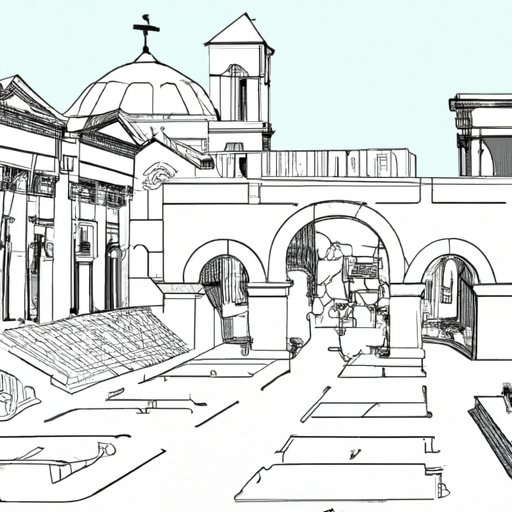Introduction
The Byzantine Empire, which lasted from 330 CE to 1453 CE, was an influential political and cultural entity that had a profound impact on the development of Greco-Roman culture. The term “Greco-Roman” refers to the synthesis of Hellenistic and Roman culture that emerged during the period of the Roman Empire (27 BCE – 476 CE). As such, the Byzantine Empire helped to preserve Greco-Roman culture through its various contributions in architecture, art, religion, scholarship, and trade.
Analyzing How Byzantine Architecture and Art Served as a Form of Cultural Preservation
Byzantine architecture and art served as powerful tools of cultural preservation. For example, the construction of Byzantine churches, such as the Hagia Sophia, served to preserve the legacy of Greco-Roman architecture. The Hagia Sophia, built in 537 CE, was designed in the style of a traditional Greco-Roman basilica and featured many of the same architectural elements, such as columns, arches, and domes. Moreover, the interior of the Hagia Sophia was decorated with mosaics and frescoes that were inspired by Greco-Roman art. These works of art incorporated the Greco-Roman tradition of depicting religious figures and scenes in vibrant colors and intricate detail.
Examining the Impact of Byzantine Religious Practices on Greco-Roman Heritage
In addition to architecture and art, the practice of Byzantine Christianity also contributed to the preservation of Greco-Roman culture. The adoption of Christianity as the official religion of the Byzantine Empire in the 4th century CE enabled the preservation of numerous ancient texts, including those written in Greek. Furthermore, the influence of Byzantine emperors on religious practices ensured that Greco-Roman ideas and values remained embedded in the culture of the Byzantine Empire. For example, Emperor Justinian I (527-565 CE) implemented a series of reforms known as the Corpus Juris Civilis, which codified Roman law and preserved many aspects of Greco-Roman culture.

Exploring the Role of Byzantine Scholars in Preserving Ancient Texts
The contributions of Byzantine scholars to the preservation of Greco-Roman literature were also significant. Many Byzantine scholars devoted their lives to studying, translating, and preserving ancient texts. For example, the scholar Photios (820-893 CE) wrote several commentaries on classical authors such as Plato and Aristotle, while the scholar Eustathios (1118-1198 CE) wrote detailed annotations on Homer’s epics. These works enabled the preservation of Greco-Roman literature and ensured that these texts were accessible to future generations.
Investigating the Influence of Byzantine Trade Networks on the Spread of Greco-Roman Ideas
The Byzantine Empire also facilitated the spread of Greco-Roman ideas through its extensive trade networks. By establishing trading posts throughout the Mediterranean and beyond, the Byzantine Empire created a commercial hub for the exchange of goods and ideas. Merchants travelling along these routes brought Greco-Roman ideas to far-flung regions, introducing new concepts to distant civilizations. This diffusion of knowledge enabled the preservation of Greco-Roman culture in places where it would otherwise have been lost.
Examining the Contribution of the Byzantine Empire in Providing a Safe Haven for Greco-Roman Culture During Times of Crisis
The Byzantine Empire provided a safe haven for Greco-Roman culture during times of crisis. The stability and security afforded by Byzantine rule enabled the preservation of Greco-Roman culture in the face of external threats. For example, during the fall of the Roman Empire, many Greco-Roman texts were destroyed due to the destruction of libraries and other cultural institutions. However, the Byzantine Empire provided a refuge for these texts, ensuring their survival and allowing them to be passed down to future generations.

Investigating How Byzantium Helped to Create a Bridge Between Greek and Latin Cultures
Finally, the Byzantine Empire helped to create a bridge between Greek and Latin cultures. Through its diplomatic efforts, the Byzantine Empire sought to promote understanding and cooperation between Greek and Latin cultures. Furthermore, the use of Greek as the official language of the Byzantine Empire allowed for communication between the two cultures. This integration of Greek and Latin cultures enabled the preservation of Greco-Roman culture in its entirety.
Conclusion
In conclusion, the Byzantine Empire played a crucial role in preserving Greco-Roman culture. Through its contributions in architecture, art, religion, scholarship, and trade, the Byzantine Empire helped to ensure the survival of Greco-Roman culture. Moreover, the Byzantine Empire provided a safe haven for Greco-Roman culture during times of crisis and facilitated the integration of Greek and Latin cultures. The lasting legacy of the Byzantine Empire on Greco-Roman culture can still be seen today.
(Note: Is this article not meeting your expectations? Do you have knowledge or insights to share? Unlock new opportunities and expand your reach by joining our authors team. Click Registration to join us and share your expertise with our readers.)
